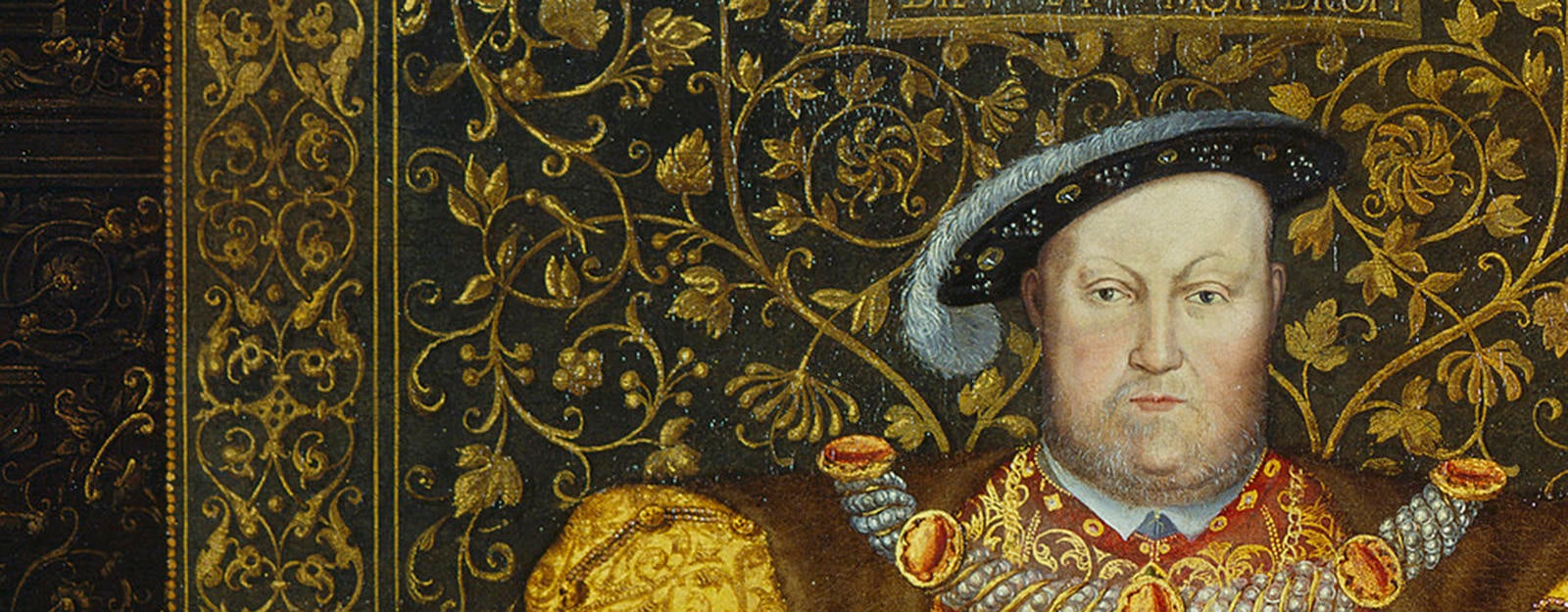Tudors
Henry VIII, King of England (1491-1547)

- Born 1491, Palace of Placentia [Greenwich]
- Died 1547, Palace of Whitehall [London]
Henry VIII was the second son of Henry VII. When his older brother Arthur died in 1502, he became the heir to the throne, to which he ascended on his father’s death in 1509. His marriage to his brother’s widow, Catherine of Aragon, failed to produce a male heir, and Henry sought a divorce. The Pope’s refusal led to the break with Rome and the establishment of the Church of England. Henry married a further five times, and his children succeeded him in turn as Edward VI, Mary I and Elizabeth I.
Henry's court was a splendid one. The young King acceded to the throne to rule a prosperous England. He undertook many building works, creating St James's Palace and the Palace of Nonsuch and he also appropriated and extended the palaces of Cardinal Wolsey, at Whitehall and Hampton Court. In addition to this he inherited Greenwich, Richmond and Windsor Castle. All of these palaces, and other residences, he furnished lavishly with tapestries and silver and gold plate. Just over 100 tapestries survive from this period in the Royal Collection, though at the time of his death Henry owned 2450. Among the greatest of these was a set depicting the story of Abraham, probably commissioned for the Great Hall at Hampton Court and a set woven from a design for Pope Leo X depicting classical gods and heroes.
Henry always had an eye to his European counterparts, most notably François I of France whose magnificent court Henry wanted to emulate. He patronised many European artists who brought their knowledge of Italy and France to England. The visual culture of the English court would have been magnificent, but the tournaments and festivities so beloved by Henry, and designed by court artists, were housed in temporary structures. Even the extraordinary Field of the Cloth of Gold is recorded only in a single painting. Very little of the interior decoration of this period survives but all accounts suggest the cosmopolitan tastes of the King.
Paintings formed a less significant part of the decoration of the palaces, but portraits and images of family members were an intrinsic part of royal life (as in this example). Early in his reign Henry commissioned effigies for the tombs of his parents and grandmother (Lady Margaret Beaufort) in Westminster Abbey from the Italian sculptor Pietro Torrigiano. Lucas Horenbout painted miniatures and Hans Holbein the Younger made drawings and paintings. Henry's own image was defined by Holbein, though again the most significant example of this, the Whitehall Mural, was destroyed in a fire in 1698 and is known only through a copy.
Armour and weaponry are some of Henry's greatest treasures in the Royal Armouries and the Royal Collection today (such as this splendid armour garniture). Henry commissioned Austrian, Italian, Spanish, German and Dutch makers, at home and abroad, and the display of armour and weapons added greatly to the visual splendour of his reign.
Reigned: 1509–47
Henry's court was a splendid one. The young King acceded to the throne to rule a prosperous England. He undertook many building works, creating St James's Palace and the Palace of Nonsuch and he also appropriated and extended the palaces of Cardinal Wolsey, at Whitehall and Hampton Court. In addition to this he inherited Greenwich, Richmond and Windsor Castle. All of these palaces, and other residences, he furnished lavishly with tapestries and silver and gold plate. Just over 100 tapestries survive from this period in the Royal Collection, though at the time of his death Henry owned 2450. Among the greatest of these was a set depicting the story of Abraham, probably commissioned for the Great Hall at Hampton Court and a set woven from a design for Pope Leo X depicting classical gods and heroes.
Henry always had an eye to his European counterparts, most notably François I of France whose magnificent court Henry wanted to emulate. He patronised many European artists who brought their knowledge of Italy and France to England. The visual culture of the English court would have been magnificent, but the tournaments and festivities so beloved by Henry, and designed by court artists, were housed in temporary structures. Even the extraordinary Field of the Cloth of Gold is recorded only in a single painting. Very little of the interior decoration of this period survives but all accounts suggest the cosmopolitan tastes of the King.
Paintings formed a less significant part of the decoration of the palaces, but portraits and images of family members were an intrinsic part of royal life (as in this example). Early in his reign Henry commissioned effigies for the tombs of his parents and grandmother (Lady Margaret Beaufort) in Westminster Abbey from the Italian sculptor Pietro Torrigiano. Lucas Horenbout painted miniatures and Hans Holbein the Younger made drawings and paintings. Henry's own image was defined by Holbein, though again the most significant example of this, the Whitehall Mural, was destroyed in a fire in 1698 and is known only through a copy.
Armour and weaponry are some of Henry's greatest treasures in the Royal Armouries and the Royal Collection today (such as this splendid armour garniture). Henry commissioned Austrian, Italian, Spanish, German and Dutch makers, at home and abroad, and the display of armour and weapons added greatly to the visual splendour of his reign.
Reigned: 1509–47